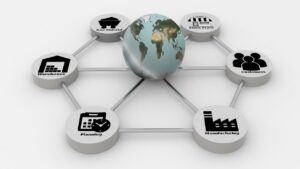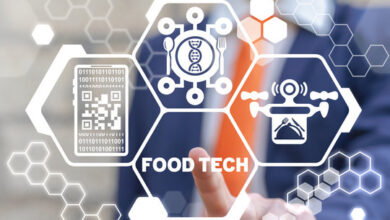Food Chain from Farm to Fork

Food Chain The term food chain refers to organisms in their environment that consume one another as their sustenance source, providing energy and nutrients between species in an organic chain structure that moves energy from the producer organism to the recipient organisms and on to decomposers, and vice versa. A more in-depth knowledge of this cycle makes apparent just how dependent certain organisms are on other ones for survival.
What is a food chain?

A food chain refers to an ecological process in which living things consume each other before being devoured by larger organisms. Energy and nutrients flow across species at various trophic levels in an ecosystem in a manner known as a “feedback loop.”. Trophic levels refer to various stages in this chain, beginning from producers at its base up to primary, secondary, and third consumers; each stage is known as a trophic stage in this food chain. A food chain comprises several main parts. Producers are autotrophs like phytoplankton, cyanobacteria, algae, and green plants that generate food through photosynthesis using solar energy for fuel. These producers form their foundation by using sunlight’s power to make food from nothing! Producers may include any organism, plant, or animal that utilizes photosynthesis for its sustenance needs, with organisms being autotrophs due to producing what they consume via photosynthesis being considered producers in general terms. Consumers refer to organisms that rely on other living organisms or plants for sustenance. A food web comprises almost all living creatures, as consumers rely heavily on each other as food sources. Consumers include herbivores that consume plants, carnivores who feed on other species for sustenance, parasites who inhabit certain organisms to harm them, and parasites who reside on certain individuals to harm them, as well as scavengers who consume decomposing carcasses after creatures have passed on, plus scavengers who consume deceased animal carcasses from consumption by other consumers—an integral component of any food web! Herbivores in this case can be considered primary consumers, while carnivores represent second-tier consumers. Both species inhabiting the second trophic layer consume producers. Therefore, herbivores, or primary consumers, include people residing within that second layer. Decomposers, organisms that derive strength from waste or lifeless natural material, represent the very last degree inside the meal chain. Decomposers play a necessary role in offering critical nutrients to soil by breaking down organic fabric into inorganic materials, which provide critical nourishment to soil ecosystems. Decomposers play an essential part in recycling substances they ingest by returning minerals into oceans or soil, where producers or autotrophs may utilize them in turn, starting a fresh food chain that extends across multiple food chains within an interlinked food web. Food webs resemble chains of food in that both consist of interlinked species eating each other; in some instances, an individual species might even be consumed by multiple predators or by multiple other species; this explains why so much of tropical biodiversity lies within one system. Food chains don’t accurately demonstrate energy flow. In contrast, the food web provides the right visualization as it shows interactions among species. With more interrelationships between various food chains forming their structure and becoming increasingly complicated over time,. Such complexity could ultimately contribute to an ecologically sustainable system.
Food Chain Integrity

Integrity is multifaceted when considering food supply chains from producer to consumer, from producers through all stages. Modern food chain integrity measures centre around factors including the microbiological and chemical safety of foodstuffs as well as source integrity (authenticity of source), fraud detection, and quality assessments. Sooner or later, customers will expect products to meet more stringent eco-friendly, animal welfare-oriented, no-child labor-free criteria, as well as trade with emerging nations’ standards for the production of high-integrity food. Food businesses must transform such consumer sentiments into objective standards for producing food with integrity. Detritus Food ChainThe detritus food chain includes various living organisms as well as plant species like algae, bacteria, and fungi, as well as protozoa and insect mites, among others. Decomposers begin feeding off dead organic matter; energy from food then gets converted to decomposers, which in turn become food sources for detritivores and decomposers, which later feed carnivorous organisms such as maggots, which become food for larger carnivorous organisms such as snakes, frogs, etc. Primary consumers include protozoans Fungi bacteria, among others, feed off decayed organic debris, while other consumers include protozoans Fungi feed off decayed material that feeds off debris before moving back upstream again into food chains that begin. One type of food chain known as food chain grazing begins with green plants and then moves on through herbivores before becoming carnivorous. With such an ecosystem in place, energy for photosynthesis becomes limited at the foundational levels of food chains, grazing or otherwise. At the root of it all lies the energy exchange between herbivores and autotrophs; from here, energy can travel back down through this food chain until reaching herbivores again for consumption. As autotrophs form the basis of nearly all ecosystems on Earth, most food chains worldwide follow this particular model of sustenance distribution. Such chains facilitate both local and international commerce through complex flows. Supply and exchange chains may both play an integral part. Regulations enforced by intergovernmental bodies provide structure for this market, while social input raises standards through private industry participation. As part of global trade in food chains, small farmers cannot participate in large portions of production both globally and locally. To illustrate its complexity in India, the United States is shown as a component in this chain. Humans play various roles within a food chain depending on what they consume as sustenance. If humans only eat plants as sustenance, then their role as primary consumers would be clear; otherwise, they are called secondary or omnivore consumers, respectively. Animals too are consumers in food chains since they consume both plants and other animals that consume plants in one way or another as consumers, producers make food, consumers eat it up before it finally ends with predators taking it all down through one continuous pathway into energy flow pathways of various sorts (in food chains it all starts from producers making food production to being eaten upstream of producers by producers making food production all the way up until topmost predators at last) where energy flows down one path while food webs present multiple energy flow paths between organisms eating multiple items consuming an organism consumes multiple items, unlike food chains where energy flows one way only through one path for energy flow while one way flow exists between producers producing energy flow pathways from one stage of energy flow while there can be multiple paths through which energy flows between various organisms in that particular chain or web structure where energy flow follows one path), one path than another when considering energy flow within this complex system of course.
Farm-to-Market Food Chain
A food chain refers to the complex distribution system for both locally produced food items as well as international supplies of them and serves both as supply and value chains. Many regulations imposed by international organizations act as the foundation for these markets. Social contributions also raise standards by engaging the private sector. Unfortunately, global trade within food supply chains kept small-scale farmers out of much of global production as well as local markets. To demonstrate the complexity of food chains in both India and America, different components from both chains have been displayed here. Strong top-down influence can result in cascading cascades of trophic elements within these food chains. One of the best-studied food chains can be found in mid-latitude lakes, where researchers have conducted extensive food chain analyses. Zooplankton and phytoplankton serve as key links between plants and herbivores, providing crucial food. These large zooplankton lakes remove phytoplankton from water at an extremely rapid pace, making them one of the world’s biggest herbivores. Lakes that contain only low concentrations of planktivorous fish tend to experience lower phytoplankton densities due to the large species of zooplankton that thrive at such conditions, significantly diminishing phytoplankton populations during the midsummer months and becoming clear. Planktivorous fish provide enough planktivorous to reduce zooplankton numbers in lakes that contain enough planktivores that consume it, mitigating any negative impacts from phytoplankton-zooplankton interactions in the summer months. Consequentially, water becomes opaque with phytoplankton blooms during that season, creating an “upward cascade of planktivores to phytoplankton.” Lakes with large piscivorous species like wall-eyed pike extend four links in their chain, and planktivorous fish populations decrease, freeing Zooplankton populations from predation. Knowledge of food chains is vitally important because it reveals intricate relationships within an ecosystem, how organisms rely on each other for survival, and how energy moves within this system. Understanding food chains helps reveal these complex interrelations as they illustrate energy flow within it and thus show us where resources lie in an ecosphere.



